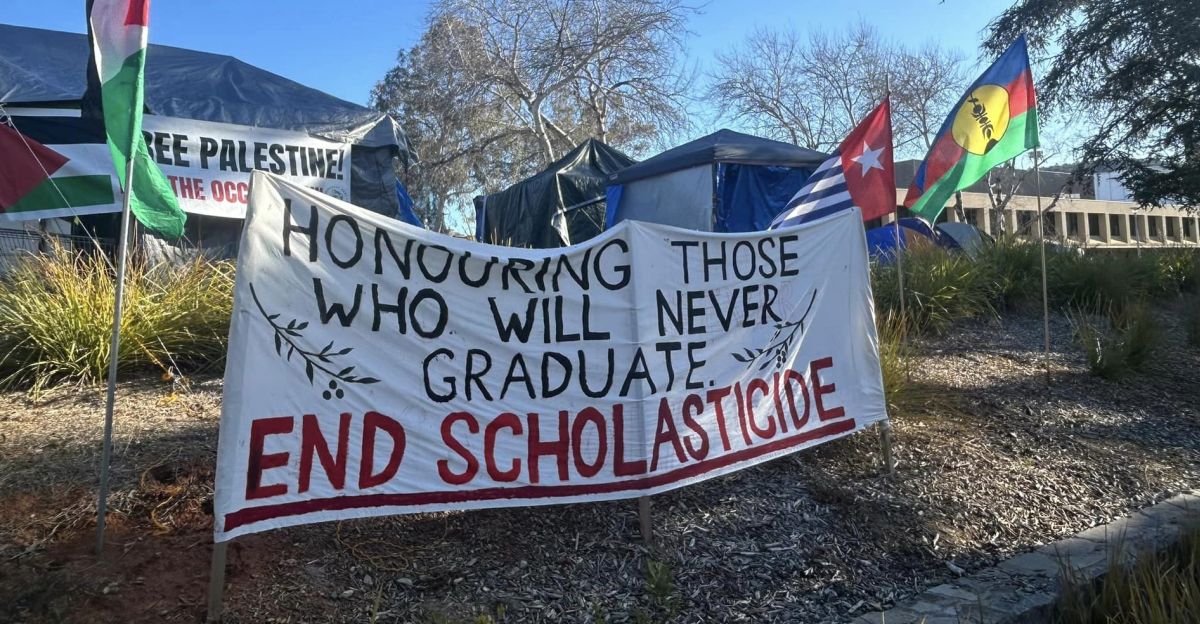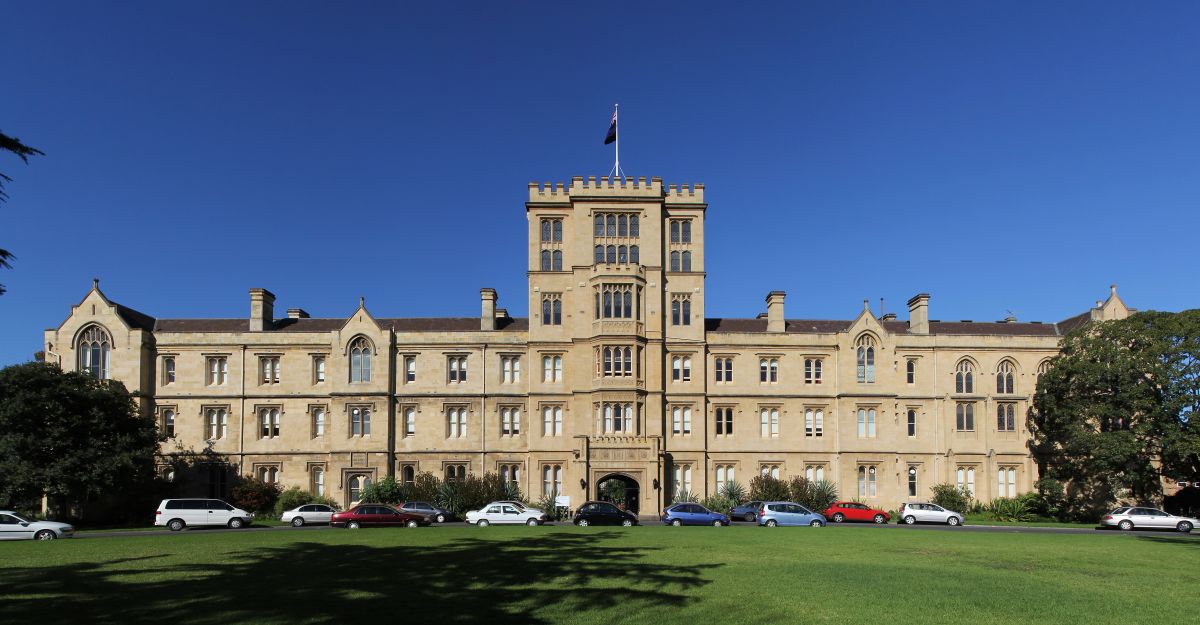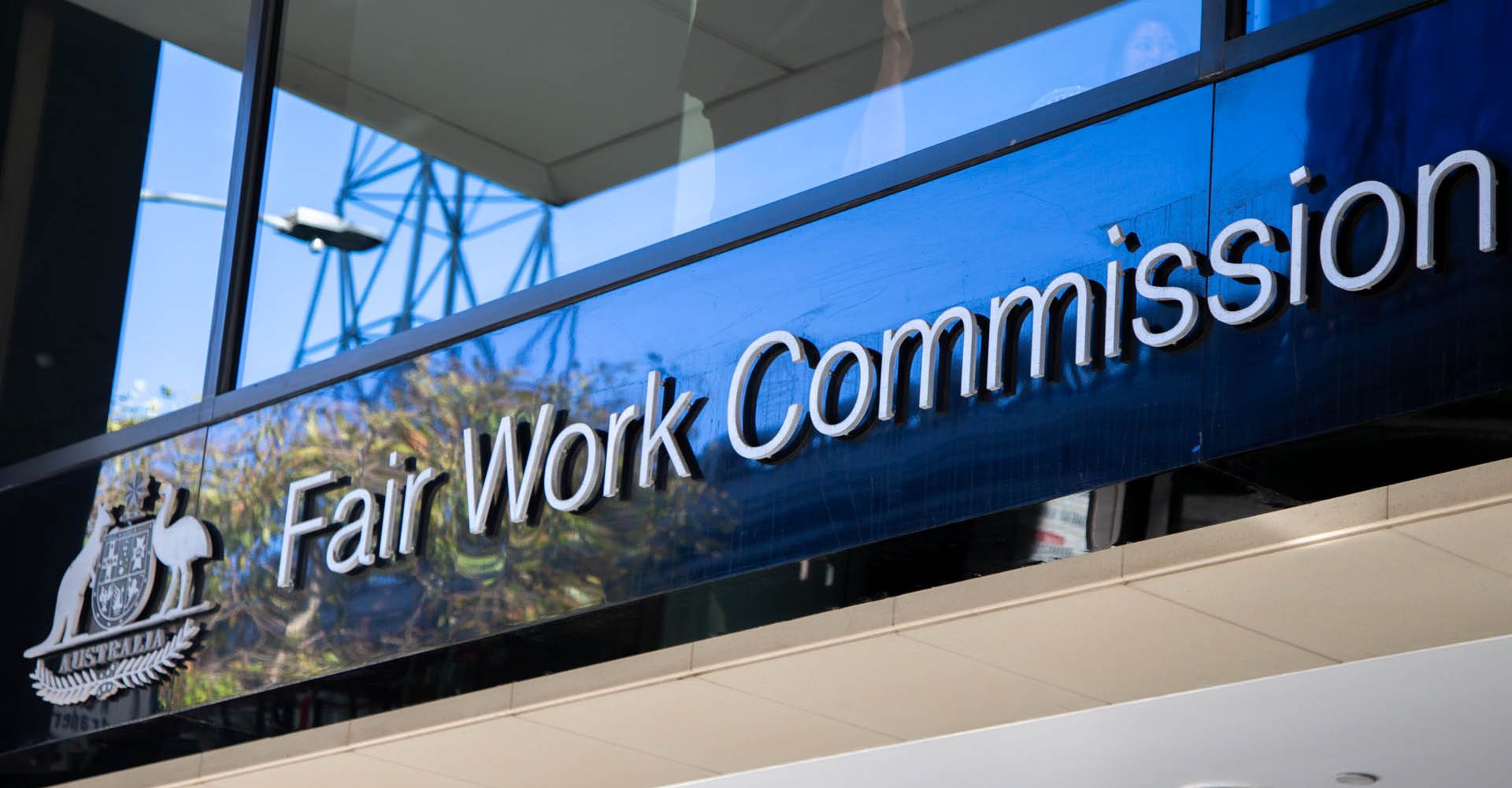Three months before the Gaza solidarity encampment embedded itself in the Kambri precinct of a renowned Australian university, an academic panel convened in the College of Law. Propelled by the ICJ verdict on South Africa v. Israel, this was among the first public discussions on the unfolding genocide in Gaza, which up until now had been unnamed by the university, buried under patronising platitudes of student wellbeing and mental health concerns over a “conflict” raging supposedly in a world out there. As Israeli F-35 fighter jets turned crowded Palestinian refugee camps into flames, as hellfire missiles struck hospitals left in ruins, and as the latest “cutting edge technology” shredded Palestinian men, women and children alike, the university issued routine email blogs as footnotes to the violence, reminding students to uphold “respect and dialogue” in their discussions of the “war” and inviting them to “exciting opportunities of technology, science and philanthropy.”
In the College of Law, the public discussion, prefaced by a ritualised acknowledgement of the “traditional (Indigenous) owners of the land” in which we met — proceeded not so much naming the genocide, but by hesitating on whether it could be legally named so. The technicalities of proving and disproving a genocide in the highest court of law not only prevailed over moral and sociological facts on the ground, but they also offered a standard for what an academic position should look like on the matter — technical, objective, and civil.
One panellist mused that Israel’s crimes — based on the technicalities of law — might be more suitably tried as humanitarian violations instead. Another panellist — a former Australian diplomat in the Hague — interjected, his voice rising in volume: “whether Israel’s crimes can be convicted as genocide or not, we know, for a fact, that Oct 7 was genocidal!” But no matter if his passionate outburst was an aberration in an otherwise technical rendition of the law, or his ‘factual’ assertion did not stand the legal test, the norms of respectful and inclusive dialogue dictated that his fellow panellists continue with polite propriety, against the rabble-rousing interruptions of an activist or two in the audience. Tempering his tone, the diplomat continued: “Palestinians and Israelis have similar claims to the land, like Hutus and Tutsis.” Again, an activist interrupted, indignant at this erasure of Israeli settler colonisation and Palestinian indigeneity. Members of the audience glanced sidelong. The moderator intervened to restore decorum. Fellow panellists continued, responding to the moderator’s questions — respectfully and to the point. And the discussion ended with a thunderous round of applause.
The public discussion may not have represented all academic positions within the university — or in the College of Law for that matter. But it provided a specific glimpse of the militarised settler university in action. In particular, it showed how the university could mobilise technocratic civility and objective inclusivity as institutional moves to innocence in the face of staggering genocidal violence.
In the months since the first public discussion, Gaza solidarity encampments have swept through campuses from North America to Australia, embedding themselves as material reminders of the university’s investments in genocide. Like the Aboriginal Tent Embassy facing Parliament Lawns in Canberra, they have held a mirror to the university’s continuing construction on dispossession. And, as if recognising themselves in the cry of the students, universities have responded in kind — disciplining students with ambiguous codes of conduct, banning them from campuses and graduation ceremonies, caring for college property (and grass patches on lawns) over human lives, and summoning the police on unsuspecting campers in the early hours of the morning.
In its encounter with the Gaza encampment, the settler university has laid itself bare, revealing its appetite for genocidal violence as well as the ideological edifice that sustains it. Once again, the claims of objectivity, inclusivity and civility have come to the fore — not just as imperial science in knowledge production — but as those inscribed in institutional practices that seek to rehabilitate the university and create an ethical distance between itself and its violent complicity. These practices have ranged from Diversity, Equality & Inclusion frameworks to (First Nations) Reconciliation Action Plans as corporate commitments to justice. They have included the use of ‘diversity hires’ in campus security to surveil campers through so-called “welfare checks” — and also, as evident in the case of Australia’s premier national university, the weaponisation of policy review processes to evade institutional complicity.
By ostensibly “including” student voices through policy submissions and constructing the notion of an objective community, such processes have insisted on the civility of dialogue that they represent. Even as the university refuses to name the genocide and continues to intimidate those who grieve and rage against it, these processes create policy fictions to disavow activism and rewrite violent facts on the ground.
*
On July 16, nine months into the genocide in Gaza and after nearly two and half months of encampment protests for divestment from Israeli institutions and associated weapons manufacturers, the Australian National University initiated a review process of its Socially Responsible Investment Policy (SRI). Ostensibly a generous move to “include” critical voices, the review came alongside a series of intimidation tactics against student protestors and an obdurate refusal to dialogue with them at the encampment.
A series of charges were laid against the encampment over time. The first charge was the students’ violation of university unspecified codes of conduct. The second was the apparent “smell” of the camp in the now corporatized “meeting place” on campus (referred through an indigenous term, Kambri). The third was the camp’s damage to a patch of grass on the lawn. Finally, the fourth charge, which came alongside a heavy police contingent, was the camp’s violation of work, health, and occupational safety through its presence in a newly-discovered fire evacuation zone.
Moving the camp fifty meters from its original location, the students persevered and forced the university to the negotiating table. Their calls for immediate divestment and action, however, have been met with policy processes to consult, review, and revise the investment infrastructure. The subsequent consultations on the university’s Socially Responsible Investment Policy received 900 submissions, but the process was already marred with concerns about transparency and methodology. Where outrage of the global community, statements of UN agencies, and provisional rulings of the International Court of Justice had failed to move the university into action, how would the consultations constitute “evidence” that filtered into policy? Who were the “experts” directed to review this evidence and present them to a Council of university bureaucrats, professional, and academic staff for recommendations? And what logics would set the parameters of its translation into a policy response?
*
While the surveys and actual deliberations of the Council are not yet public, the logic and rationale of the initial reviewers — drawn from the university’s Investment and Financial Office — can be gleaned from a virtual Town Hall held in the aftermath of consultations. Here, the university’s financial and investment officers presented their methodology of ethics: a quantitative approach to “screen the investable universe;” to scan companies that fail “negative screens;” to quantify the impact of “screens” on risks and returns; and to include corporate ESG (Environmental, Social, & Governance) benchmarks for “positive” investment goals in favour of gender equality and climate risk mitigation. Here, “negative screens” (on revenue thresholds of 20 per cent and more from pornography, tobacco, gambling, and coal) determined the ethics of the policy. Never mind if the cumulative revenue of all the screened companies earning less than 20 per cent exceeded the atomised prohibitions, as one astute member of the encampment observed in the Town Hall.
But such was the quantitative methodology of ethics — excluding institutional partnerships with defence companies such as BAE Systems and Thales. In the rationale for exclusion, the argument of national security was key, with national security as an objective imperative standing outside the need for reason. Also in their rationale was the companies’ contribution to jobs — as the financial officer highlighted painstakingly — and their corporate support for 6 First Nations businesses in Australia. Here in a Town Hall designed to educate students, alumni, and staff on responsible investment, the university presented its quantitative benchmarks as an ideological defence of the status quo, subsuming ‘social good’ within its structured rationale of national security, economic incentives, and risk-returns.
At the Town Hall, the Chief Financial Officer continued:
If you have looked at the history of our policy, you will see it has evolved over time. And now we are looking at this process again. We are always trying to push the envelope, trying to include more “measuring sticks” that become available in the industry and more widely accepted in the industry. We apply them immediately to the Long-term Investment Pool (LTIP) to enable both the Finance Committee and Council a better understanding of what’s happening.
When students in the audience objected to the “pointlessness” of the policy exercise in the face of genocide (“What about the ongoing “social harm” to Palestinian, Muslim, and BIPOC students? Will the university refuse to make actual decisions and conduct a consultation every time it is found implicated in social harm?”), the presiding financial officer responded:
We have heard your feedback. We must emphasise that the community is paramount to us. We consider the well-being of [pause, eyebrows raised] all our community.
As evident in these exchanges, the consultation process relied on a seemingly objective — and at times, mythical — construction of a community, flattening out differences in privilege and experiences of epistemic and physical harm. From time to time, the university bureaucrats also wielded the quantitative “measuring sticks” against the protesting students at the Town Hall, disciplining their objections as impatience to a rationalised process. The protestors were but a small part, and at times, even outside the confines of a civil community governed by standards of risks and returns and financial benchmarks developed elsewhere.
As critics have highlighted in the case of ESG ratings for “positive” investments, benchmarking indices are often determined by external financial rating agencies, self-reported by organisations, and conducive to greenwashing. Often, they measure the risks of their objectives (such as carbon reduction or carbon intensity) on financial performance, rather than the actual impact on the environment. Or in the case of negative screens, they set thresholds on terms relative to a company’s total revenue, rather than its actual contribution to social harm, allowing for millions of dollars to remain invested in unethical sources.
Here, too, predetermined indices not only determined the methodology of ethics but also subjected the urgency of divestment from genocidal complicity to an evolutionary logic. The social harm of a genocide already meted out on the Palestinians could be conceded in the service of a forward-looking process. Morality in the here and now could be deferred for the sake of more evolved “sticks” in the market.
*
It is not surprising, then, that the outcome of this consultation process has failed to satisfy staff and student advocates of Palestine, including members of the Gaza Solidarity Encampment. On August 13, the ANU announced updates to the Socially Responsible Investment Policy, which include a resolution that the University’s Long Term Investment Pool will add negative screens (thresholds unspecified) for “controversial weapons manufactures” and civilian small-arms manufacturers. It also affirmed additional “positive screening related to gender equality, and First Nations-led companies.” Yet, as the (former) Gaza Solidarity Encampment has noted, research partnerships with Israeli institutions remain intact and
there is no commitment to immediately address their current holdings in companies assisting this genocide, including Raytheon, BAE Systems, and Northrop Grumman. It is unclear whether this new policy retroactively applies to already held investments, and the ANU has stated it will take time to implement this policy change. Time in which Palestinians will continue to be slaughtered, aided by this university’s over one million dollars invested in companies complicit in genocide.
Furthermore, while the new policy claims to exclude “controversial weapons manufacturers” without naming names, critics have already made parallels to several superannuation fund companies who have relied on the same terminology to include and exclude divestments at their discretion. The word “controversial” here is key, as in the case of super fund companies, allowing for a host of legalistic distortions on the right to combat in a supposedly “just war.”
There is also supreme irony in the university’s ethical rationalisation of the existing SRI policy based on negative screens for carbon intensity. In 2013, the university developed the Socially Responsible Investment policy in response to sustained pressure from the ANU fossil free campaign, led by a cross-section of environmental groups and student organizations calling for divestment. With the newly adopted policy, the university could now claim moral high ground even as leaders of the Fossil Free campaign criticized it for being “extremely vague” and for “dismissing” the question of divestment through the application of negative screens. These criticisms continue to date, with incremental goals of carbon reduction now featuring as part and parcel of the university’s distancing act from its genocidal investments.
In the aftermath of the Review, many bureaucrats and academics have praised the university for its response, with some pro-Palestine social media accounts mistaking it as a divestment win similar to that of King’s College, London. There is no doubt that the ANU encampment, as the longest running in Australia, has been a force to reckon with. Even the incremental policy revisions could not have been possible without it. However, the consultations have also produced policy fictions to rewrite violent facts on the ground, whilst inscribing intentional as well as strategic ignorance in its processes.
In 2020, for instance, members of a student and faculty led Management Fund submitted a version of the SRI policy to the university, which called for negative screens on armaments and alcohol. These recommendations, despite being lauded in business courses and developed through extensive academic input, were ignored by university management. Four years on, in the aftermath of the consultations, we are to assume that the “evidence” for armament exclusion has suddenly just materialised; we are to adhere to the supremacy of process over decision (unlike the academic boycott of Russia); and we are to believe the university’s ethics and commitment in divesting from a genocide it cannot even name.
Such forms of structural evasion through “technocratic speak” or bureaucratic policy processes are neither new nor unique to the university. But the ferocity with which the university has employed them reinforces how oppression works in the settler colony through ostensible practices of inclusion. Here, too, movement demands are “included” only to be generalised, tokenised, and hollowed out.
And yet, the claim of objectivity as inscribed in process can appeal to many residing within the institution, in a manner that cannot always be undone with residual facts about genocidal investments. It suspends judgment. And this speaks to a larger problem. It reveals what is at stake ideologically for the militarised settler university and the myths that sustain its violence. The myth of a settler university as an intrinsic home for critique. The myth of a settler institution evolutionised with time, with objective claims to truth. The myth of the institution as a third space, apart from the government and outside of society, mediating compulsions for scientific research as well as (siloed) social scientific critiques of them. So long as these myths endure, so does the distance between university and its violent complicity.
Postscript: critique from a war machine
On the morning of Reconciliation Day, a public holiday to celebrate Aboriginal and Torres Strait Islander culture and for Australians to congratulate one other for standing “better together” with the (Indigenous) First Nations peoples, the settler university called the police on student campers protesting a colonial genocide. In response, siloed conversations took centre stage, hushed criticisms turned to momentary outrage. Inadvertently, perhaps, many academics also reproduced the image of the university as a third space, an intrinsic home for critique. This is not who we are. This is not what we are supposed to be.
But was the settler university acting in aberration or in character? With its land acknowledgements that refused to name genocide, past and present? With its Reconciliation Action Plans to support Indigenous businesses here, and colonial extermination there?
The military-industry-academic complex has always been an open secret. But the encampment has forced a kind of reckoning, demanding that paywalled criticisms turn into public protests; siloed conference discussions into action for material change. The masks are off and we must confront. Is colonial violence really not the foundation of the Western settler university? Is epistemic erasure not part of its ongoing epistemology? Are claims of inclusivity, objectivity, and civility not its ideological moves to innocence?
And, if the answer is yes, then how has the settler university appropriated spaces of siloed critique to reproduce its hegemony? And how have we — who engage in the business of critique from within its quarters, who draw wages from its stolen wealth, who set ourselves as critics and not complicit actors –- sustained its violence?
The author would like to thank members of the (former) ANU Gaza Solidarity Encampment for allowing us all to learn with, and alongside, them.



